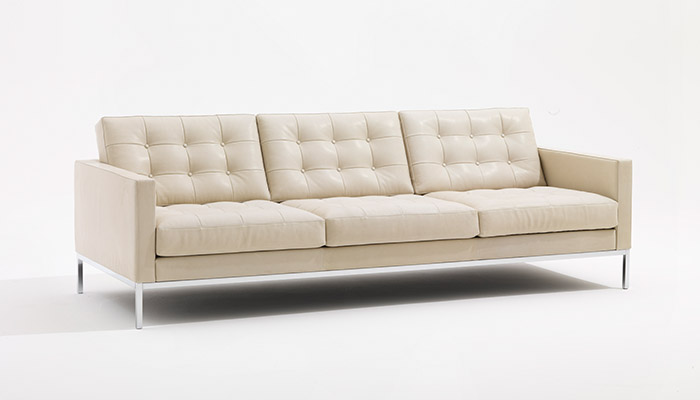
New York, February 7, 2017—Inspired by a century of the acclaimed designer Florence Knoll Bassett, who turns 100 this year, a range of new products will be added to the Florence Knoll Collection. These additions include the Florence Knoll Relaxed Lounge Seating, Dining Tables, Mini Desk, and Hairpin™ Stacking Table.
Often denying the status of decorator or designer in favor of simply being an executor of good taste, the young Florence Knoll took on a variety of projects in her years with the Planning Unit, a division of Knoll that she founded in 1946. In the process, she designed a great deal of furniture that, while intended simply as “fill-ins” for commercial projects, have since become standalone icons of modern furniture design that suit workplaces and residences alike.
With her natural eye for design and her famous refusal to compromise on perfection, Florence Knoll devised solutions to office problems that had never been recognized or addressed before. By 1950, over a third of the 63 products offered in the Knoll Associates price list had been designed by Florence Knoll.
Her Lounge Collection, first introduced in 1954, testifies to this understated commitment to quality. Poised on sleek metal frames, the Lounge Chair, Settee, Sofa all bear clear geometric profiles that celebrate the Bauhaus tenets of rational design, principles that Florence Knoll undoubtedly imbued from her mentor, Mies van der Rohe, during her studies at the Illinois Institute of Technology.
In celebration of the legacy of the pioneering designer, Knoll will present a new set of residential designs inspired by the archival products. The Florence Knoll Relaxed Lounge Seating collection will introduce softer, deeper cousins to the classic Sofa, Settee, and Lounge chair, their generous cushioning to meet the requirements of comfort and calm in the modern home.
Further additions to the Florence Knoll line include a series of Dining Tables and a Mini Desk that will similarly echo the successful form and proportion of her past designs of Side and End Tables. The Dining Tables and Mini Desk will be available in a range of marbles, while the Mini Desk will additionally be offered in glass, lending the pieces enough range to be adapted to the tone of any environment.
While less widely recognized than her classic lounge collection or parallel bar furniture, Florence Knoll’s early design for a wire base stool has become an equally legendary example of sleek, Bauhaus-inspired American furniture since its introduction in 1948. In celebration of her 100th year, the design will be revived from the Knoll archive and reintroduced as the Florence Knoll Hairpin™ Stacking Table.
First prototyped in the early 1940s, the Model 75 stacking stool became an instantly popular addition to what was then still a small catalog of furnishings from Knoll Associates. While Florence Knoll based the compact design on earlier studies using steel rods during her time at the Cranbrook Academy of Art, other reports cite the iconic 1933 wooden stacking stool designed by Finnish modernist Alvar Aalto as an equal influence. Whatever the stimulus, the final result was an exquisite composition of birch and enameled metal, its proportions calibrated by Florence Knoll’s exacting eye, remaining in production until 1966.
The Florence Knoll Hairpin™ Stacking Table will be made of a painted steel and laminate and can stack up to five tables. As Florence Knoll always intended, the Stacking Table does not just hold its own as a timeless piece of design—it proves its true value in its ability to round out the composition of any inhabited space. By the bed, in the library, next to the pool, or in the nursery, the Hairpin™ Stacking Table demonstrates good design not simply in the succinctness of its form, but the sheer versatility of its uses.
Contact